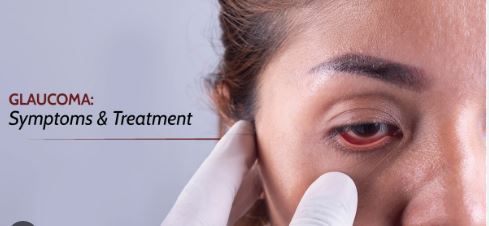Understanding and Exploring Genetic and Hereditary Risks of Glaucoma
Worldwide, glaucoma is the main cause of blindness, and millions of people are affected by glaucoma disease. In this blog post we will so what are the Genetic and hereditary risks of Glaucoma? Regular checkups and tests can help us understand the genetic and hereditary risks of glaucoma along with its role in genetic development.
1. What is Glaucoma?

Before diving into the genetic and hereditary risk of glaucoma, It’s essential to understand what is Glaucoma? Glaucoma is a group of eye diseases that can damage the optic nerve. This happens due to increased pressure inside the eye, called intraocular pressure. The optic nerve transmits visual information from the eye to the brain. When optic nerve is damaged, it can lead to vision loss and sometimes even blindness if not treated in time. Glucoma is often called a “silent thief of sight” as it can cause damage to the optic nerve without showing its general symptoms early. However, in this blog, we have tried to explain the symptoms of glaucoma along with the genetic and hereditary risks of Glaucoma.
2. Is Glaucoma hereditary or Inherited?

Various studies have shown that people with a family history of glaucoma are at a higher risk of developing glaucoma. The development of the most common form of glaucoma primary open-angle glaucoma (POAG), can also be determined using genetics. The risk of glaucoma increases if one or more close relatives, such as parents or siblings, have glaucoma.
3. Family History and Increased Risk
A family history of glaucoma can increase the risk of having the disease by up to 4-9 times with a specific type of glaucoma. The risk increases even higher if both parents have glaucoma.
It’s important to have regular eye exams to monitor eye condition and detect early signs of the disease. Early detection is key to managing glaucoma effectively and preventing vision loss.
4. Genetic Mutations and Glaucoma
One of the main genetic and hereditary risks of Glaucoma is Genetic Mutations. Scientists have identified that several genes are associated with glaucoma, which can explain its hereditary nature. Also, genetic mutations can increase the risk of developing glaucoma. One of its examples is the MYOC gene mutation which can create a form of glaucoma called juvenile glaucoma. This type of glaucoma typically affects younger individuals. Another gene called OPTN is associated with normal-tension glaucoma where intraocular pressure of the eye remains normal but optic nerve damage still occurs.
We can’t say that all cases of glaucoma are directly associated or linked with genetic mutations but it is important to understand the genetic mutation link which can help researchers to identify individuals that are at higher risk and can develop better diagnosis accordingly.
5. Genetics vs. Environment: The Interaction Factor
There are several Genetic and hereditary risks of Glaucoma but along with that, there are some other factors such as environmental and lifestyle influences which can also contribute to increasing the chances of glaucoma. High intraocular pressure, diabetes, poor circulation, and other age-related problems are some of the factors that can all increase the chances of developing glaucoma.
Glaucoma can also occur in people with no family history or any genetic mutations but are affected by these environmental factors and other underlying health conditions mentioned above. There are more likely chances of having glaucoma at an earlier age if a family history of glaucoma is there.
6. What to Do if You Have a Family History of Glaucoma
It is very important to take proactive steps if you have if you have family history of glaucoma as it can help you take the proper medication and diagnosis.
Get regular eye exams:
Start getting eye exams and regular checkups at an earlier age of around 35 if you have a family history of glaucoma. Get proper medications and precautions based on your risk factors. Follow your eye care provider’s advice and get guidance on how often you should get the checkups.
Know your family’s health history:
Knowing the family’s medical history of glaucoma and sharing this with your doctor is very crucial. This can help you to get guidance on how frequently you should get the checkups. Getting proper medications and treatment is very important to get the expected outcome of the disease otherwise it can lead to damage of the optic nerve or vision loss in some cases.
Lifestyle modifications:
Eating a healthy diet, exercising regularly, managing high blood pressure, and maintaining your body is very crucial for better health. You can’t change the genetic or hereditary effects but you can change your daily lifestyle. Keeping a healthy immune system and maintaining a healthy body can reduce the risk factors for glaucoma.
7. Types of Glaucoma with symptoms and Genetic and hereditary risks of Glaucoma

Primary Open-Angle Glaucoma (POAG)
In POAG, the eye’s drainage system becomes less efficient over time which can increase intraocular pressure. This is the most common form of glaucoma. This type of glaucoma can be linked with genetic mutations. A family history of this type of glaucoma can increase the chances of having the disease by more than 80%. Primary open-angle glaucoma (POAG) loci discovered by GWAS. Some of the symptoms associated with Primary Open-Angle Glaucoma (POAG) are:
Gradual loss of peripheral vision:
Many people may not notice this until the vision loss is significant as it starts with the loss of side vision and it is also the most common early signs of glaucoma.
Tunnel vision
If the peripheral/side vision is not taken care of properly, it can lead to tunnel vision in the future, where only the central vision remains intact.
No pain or discomfort:
Peripheral/side vision develops slowly and can create redness in your eyes.
Angle-Closure Glaucoma:
Angle-Closure Glaucoma is very common in people and it can occur when the drainage angle in the eye becomes blocked this can lead to a sudden increase in intraocular pressure which leads to a medical emergency. Talking about genetic factors, this type of glaucoma is less directly linked to genetic or hereditary factors. In some cases, individuals with certain inherited features such as narrow-angle in the eye are at greater risk of having Angle-Closure Glaucoma.
Here are some symptoms associated with Angle-Closure Glaucoma:
Sudden pain in eyes associated with Nausea and vomiting
Blurred vision
Rainbow-coloured halos around lights
Redness of eye
Normal-Tension Glaucoma
In Normal-Tension Glaucoma, the intraocular pressure remains within the normal range but the optic nerve becomes damaged. With no noticeable discomfort, this type of glaucoma is having a gradual loss of vision. Symptoms of this type are similar to open-angle glaucoma.
Some research and studies suggest that genetic and hereditary factors can contribute to and increase the chances of the development of Normal-Tension Glaucoma.
Congenital Glaucoma
Congenital Glaucoma is present at the time of the birth of an individual and mostly occurs in infants and children. This type of glaucoma occurs due to a genetic defect in the eye’s drainage system. This type is typically passed through inheritance and is common in most of the populations.
Below are some of the symptoms of Congenital Glaucoma:
Enlarged eyes or cornea
Light sensitivity
Opaque and cloudy cornea
Irritation and Eye pain
8. Age and Glaucoma Risk

Age is a crucial factor for having a glaucoma. For example, people aged more than 60 years are more vulnerable to Primary open-angle glaucoma. As age increases, the ability to drain the fluid may decrease and hence increase the intraocular pressure. Along with the age factor, if you have a family history of glaucoma then the risk of having the disease increases by 80%. If you are in that age group or you found some symptoms of the disease then regular checkups and eye exams are crucial for early detection and management.
9. Early Detection and Regular Eye Exams
For those with family history and hereditary issues, regular eye exams are essential for detecting glaucoma early. Until it has progressed significantly individuals may not be aware they have glaucoma as glaucoma typically has no symptoms. So, it is essential to have an early test or eye exam that includes measuring intraocular pressure and inspecting the optic nerve to detect glaucoma before significant damage occurs. There are many benefits of early testing as you can take proper treatment such as medication, laser therapy, or surgery that helps you prevent further damage and vision loss.
10. The Future of Genetic Research in Glaucoma
Genetic counseling can play an important role in helping families understand their risk and make proper decisions and treatments for eye health. There is research going on for the genetics of glaucoma. As per the research, scientists have uncovered the genes associated with different types of glaucoma. This can help individuals and lead to new inventions to predict the risks in individuals, help them get proper treatment, and improve their diagnosis. New inventions can lead to more personalized treatment plans for an individual’s genetic profile. Now, we can say that genetic counseling can play a crucial role in helping individuals understand the risk of glaucoma and make proper decisions and earlier diagnosis and treatment for eye health.
Conclusion
In the end, we can say that glaucoma is a hereditary disease and an individual who has a family history of the glaucoma can have significantly increased the chances of the disease. Along with that lifestyle choices such as a healthy diet, exercising regularly, and managing high blood pressure are crucial for a healthy and disease-free body. If any of your nearest family members have glaucoma disease, then take proactive steps toward eye health. Early tests/exams and regular checkups can prevent vision loss. Early detection, proper treatment, diagnosis, and a healthy lifestyle can help you manage glaucoma effectively and efficiently with a proper cure.
Is glaucoma inherited from the mother or father?
We have already identified there are genetic and hereditary risks of glaucoma. We can not say if it is strictly inherited from the mother or father. It can be from either side of the family. The type of glaucoma depends upon the inheritance pattern. Primary Open-Angle Glaucoma (POAG) is a type of glaucoma where genetic risk can be influenced by multiple genes and inheritance is usually complex where genetic and environmental factors can affect the individual.
Can hereditary glaucoma be prevented?
Hereditary glaucoma can’t be prevented as it is influenced by genetic factors. Multiple ways through which you can detect it early and manage it effectively. By doing so you can significantly reduce the risk of vision loss. Early detection and regular Monitoring are key in reducing the risks of glaucoma. Timely checkups and regular tests can also help you manage the condition well and help to reduce further damage.
What age does glaucoma usually start?
Glaucoma can develop at any age so it is tough to give a specific age when glaucoma can start. Primary open-angle glaucoma, the most common type, begins over the age of 40. After the age of 60 the risk of developing glaucoma increases. Other forms of glaucoma that can occur at an early age, such as Congenital glaucoma which is present at birth but is rare. Another type is Juvenile glaucoma which can affect between the ages of 10 and 30.
How to avoid glaucoma?
As glaucoma can’t always be avoided completely but there are several steps you can take to lower your risk. Get Regular Eye Exams can help you detect it early and early detection and treatment are key to managing and preventing further damage. The second is to maintain Healthy Eye Pressure. If the IOP is high, then you need to lower it by taking proper guidance from your eye specialist. In some cases, it is also recommended to use eye drops, medications, or surgery. Maintaining a healthy lifestyle such as exercising regularly, avoiding smoking, and eating a healthy diet are some key factors in lowering the genetic and hereditary risks of glaucoma.
Reviewed By
Dr. Sonam Aggarwal
lMBBS, MD(C.Medicine)
